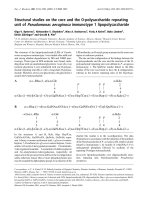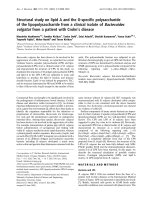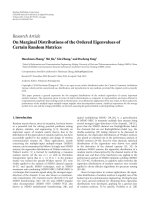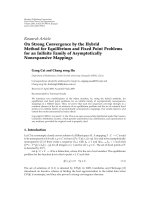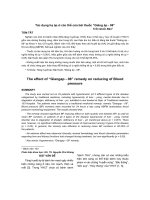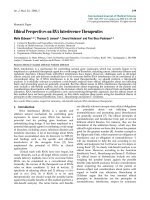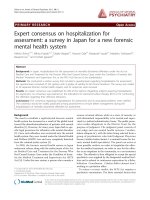Báo cáo y học: " International perspectives on intensive care at the end-of-life: the futility movement seems alive and well" ppt
Bạn đang xem bản rút gọn của tài liệu. Xem và tải ngay bản đầy đủ của tài liệu tại đây (97.32 KB, 2 trang )
95
Available online />A recent book entitled ‘Three Patients: International
Perspective on Intensive Care at the End of Life’ [1], edited
by Drs Crippen, Kilcullen, and Kelly, provides a fascinating
window into the complex issue of use of the principle of
medical futility in critical care practice. The editors
constructed three cases, designed to range from a patient
likely to benefit from the therapy we call ‘intensive care’ to a
patient for whom this therapy would provide no benefit and
therefore could be considered medically futile. They then
identified critical care physicians from 11 countries around
the world to comment on how they would approach treating
these patients both under current circumstances in their
country and under circumstances of unlimited resources.
What follows is a fascinating collection of remarkably
different approaches and rationales. Some critical care
physicians believed that the first patient, a case that may
clearly benefit from critical care, would not benefit and
therefore should not be offered this treatment. On the other
hand, the patient who, from the editors’ perspective, ‘cannot
be saved by any means and should be denied critical care on
the basis of medical futility’ evoked from some physicians a
recommendation for a trial of intensive care. This variation in
approach to critical care at the end of life is not surprising
and has been described previously within a single country
[2]. Furthermore, considerable international variation in the
approach to critical care at the end-of-life has also been
described [3]. What this book adds to these important issues
is that it demonstrates considerable variability in the
rationales toward application of the principle of medical
futility, and variation in the way in which resource constraints
effect the clinicians’ reasoning.
I find this book most interesting in the insight that it provides
into the American experience with confronting the principle of
medical futility. In 1991, the American Thoracic Society
defined a life-sustaining intervention as futile ‘… if reasoning
and experience indicate that the intervention would be highly
unlikely to result in a meaningful survival for that patient’ [4],
and reasoned that such therapy could reasonably be
withheld without consent from patients or their families.
Several years later, the Society for Critical Care Medicine
came to similar conclusions [5]. There have been cogent
descriptions of the definition and value of this principle in
medical decision-making [6,7] and evidence has been
reported that the principle of futility is currently being used in
clinical practice in the USA [8]. There have also been cogent
arguments made against the use of the futility principle
[9–11], and a recent article proclaims the ‘fall of the futility
movement’ based on these arguments [11]. The book edited
by Crippen and colleagues provides persuasive, albeit
anecdotal, evidence that declaration of the ‘death’ of the
futility movement is certainly premature, if not a misdiagnosis.
It provides insight into current clinical practice throughout the
world, as well as commentaries on this practice from
prominent leaders in the field. In the end, the book is not able
to summarize the multiple perspectives on the issue of
medical futility in a comprehensive way or to provide a
consensus approach to this issue. This limitation is not a
shortcoming of the editors or chapter authors, but is rather a
reality of our current fractured and contentious approach to
the appropriate use of the principle of medical futility in
clinical practice. Nonetheless, the book provides useful
insights into this complex issue and opens another chapter in
Book report
International perspectives on intensive care at the end-of-life:
the futility movement seems alive and well
J Randall Curtis
Associate Professor, Departments of Medicine, Health Services, and Medical History and Ethics,
Schools of Medicine and Public Health and Community Medicine University of Washington, Seattle, Washington, USA
Correspondence: J Randall Curtis,
Published online: 23 December 2002
Critical Care 2003, 7:95-96 (DOI 10.1186/cc1859)
This article is online at />© 2003 BioMed Central Ltd (Print ISSN 1364-8535; Online ISSN 1466-609X)
Keywords: critical care, intensive care, international, medical futility
Crippen D, Kilcullen JK, Kelly DF: Three Patients: International Perspectives on Intensive Care at the End of Life.
Boston, MA. Kluwer Academic Publishers; 2002. 275 pp. ISBN 0-7923-7671-4 (Hbk)
96
the fascinating history of the debate on medical futility and its
use in critical care practice.
Competing interests
None declared.
References
1. Crippen D, Kilcullen JK, Kelly DF: Three Patients: International
Perspectives on Intensive Care at the End of Life. Boston, MA:
Kluwer Academic Publishers; 2002.
2. Cook DJ, Guyatt GH, Jaeschke R, Reeve J, Spanier A, King D,
Molloy DW, Willan A, Streiner DL: Determinants in Canadian
health care workers of the decision to withdraw life support
from the critically ill. JAMA 1995, 273:703-708.
3. Vincent JL: Forgoing life support in western European inten-
sive care units: results of an ethical questionnaire. Crit Care
Med 1999, 16:1626-1633.
4. American Thoracic Society. Withholding and withdrawing life-
sustaining therapy. Ann Intern Med 1991, 115:478-485.
5. The Ethics Committee of the Society of Critical Care Medicine:
Consensus statement of the Society of Critical Care Medicine
Ethics Committee regarding futile and other possibly inadvis-
able tratments. Crit Care Med 1997, 25:887-891.
6. Schneiderman LJ, Jecker NS, Jonsen AR: Medical futility: Its
meaning and ethical implications. Ann Intern Med 1990, 112:
949-954.
7. Schneiderman LJ, Jecker NS, Jonsen AR: Medical futility:
response to critiques. Ann Intern Med 1996, 125:669-674.
8. Curtis JR, Park DR, Krone MR, Pearlman RA: Use of the medical
futility rationale in do-not-attempt-resuscitation orders. JAMA
1995, 273:124-128.
9. Lantos JD, Singer PA, Walker RM, Gramelspacher GP, Shapiro
GR, Sanchez-Gonzalez MA, Stocking CB, Miles SH, Siegler M:
The illusion of futility in clinical practice. Am J Med 1989, 87:
81-84.
10. Burt RA: The medical futility debate: patient choice, physician
obligation, and end-of-life care. J Palliat Med 2002, 5:249-254.
11. Helft PR, Siegler M, Lantos J: The rise and fall of the futility
movement. N Engl J Med 2000, 343:293-296.
Critical Care February 2003 Vol 7 No 1 Curtis

